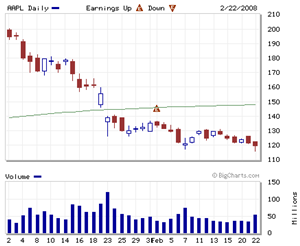Apple: The angst vs. the reality

It's open season on Apple these days. The stock is in a tailspin. Worries abound. The iPod market is saturated. The consumer wallet is pinched. It all adds up to an ugly stock chart. But it's time for a reality check here. Is all this angst really warranted?

Here's a look at the angst and the reality check that goes with it:
The angst: Apple is cutting the price of the iPod shuffle to goose units because growth is slowing. Last week, Apple announced that the 1 GB iPod shuffle will retail for $49, down from $79. Apple will also launch a 2 GB version for $69.
J.P. Morgan analyst Bill Shope wrote in a research note:
With relatively slow unit growth in the holiday quarter and Apple's price drop, signs point to iPod saturation and some macro sensitivity. Interestingly, in our recent meeting with management the company cited shuffles as a particular weak spot in the December quarter. This price cut is likely intended to boost shuffle momentum and iPod units overall.
The reality: Of all the concerns about Apple, fears about market saturation and the iPod are the most on target. Everyone has an iPod and some folks have three. Meanwhile, the shuffle would be the most economically sensitive since the device caters to the lower end of the market.
However, folks are reading a lot into a price cut on the shuffle. With the $69 shuffle it's likely that Apple will help balance out its average selling prices on the music player with a bump in volume. Another thread to consider: What does it cost to make a shuffle? $10, $7, maybe even $5. The point: Apple isn't sacrificing margins here. Data point: Piper Jaffray analyst Gene Munster notes that Apple maintained the $79 price on the shuffle for 500 days, more than twice as long as other iPod price levels. That's not exactly a show of weakness. Munster is projecting that Apple will ship 11.3 million iPod units in the March quarter.
The angst: A slowdown in consumer spending will ding Apple. The worries about the iPod shuffle pricing illustrates a bigger concern: Apple could get whacked by a consumer spending downturn. Apple is heavily exposed to consumer spending as most of its business relies on them. Enterprise sales are a rounding error to Apple at best.
The reality: Apple's outlook for the March quarter left a little to be desired, but the company has a history of being conservative. Underpromise and overdeliver is the mantra. Meanwhile, HP delivered a strong quarter that included big gains in notebook PCs. That bodes well for Apple's refreshed MacBook line-up. Simply put, Mac momentum may be enough to offset any weakness elsewhere.
The angst: The iPhone isn't a huge hit. Unlocked phones are a disaster for Apple, which expects to sell 10 million iPhones in 2008. The iPhone still suffers from lofty expectations. The big question is whether the iPhone can hit the 10 million unit mark. Perhaps a larger concern is that a big chunk of iPhones are unlocked. Why is that important? Apple sells the device, but doesn't garner any carrier revenue for an unlocked iPhone. In addition, these unlocked phones take away Apple's leverage with carriers. Why would an international carrier share revenue with Apple when unlocked iPhones can land on its network anyway?
The reality: Handicapping whether Apple can hit the 10 million mark for iPhone units is a bit academic. Aside from a few Wall Street analysts, who have fancy spreadsheet models based on 10 million iPhones sold, no one cares if Apple sells 9 million or 10 million units. It's a successful launch by any metric you use. However, the unlocking issue could be worrisome because it erodes Apple's potential revenue stream. Then again, you shouldn't cry for Apple--the margins on the iPhone are still healthy. For now, iPhone worrywarts need to relax a bit.
The angst: The MacBook Air (see Jason O'Grady's diary) wasn't that Macworld headliner folks were hoping for. In addition, sales of the MacBook Air may not totally impress.
The reality: Let's face it, Macworld 2008 couldn't have lived up to the iPhone juiced 2007 version. But it would be foolish to fret about the MacBook Air's demand yet. Apple has a nice cycle going with its MacBooks. Apple dominates Amazon's best seller list, Best Buy is ramping up its Mac shelfspace and the MacBook Air has been well received. More importantly, the MacBook Air isn't cannibalizing Apple's other notebooks, according to Munster, who surveyed resellers.
However, Munster did note that customers were curious about the MacBook Air, but "less willing to buy the MacBook Air than they were with the original MacBook." Perhaps that reaction is due to pricing, smaller customer wallets or concerns about features. But we won't really know what's going on with MacBook Air demand for a few quarters. All we know is that the MacBook Air rounds out an impressive lineup for Apple (see Munster's chart below).
Add it up and there are reasons to worry about Apple, but let's not get too overwrought about it. The next two quarters will tell the tale. Stay tuned.